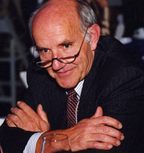Animosity toward perceived outsiders remains a powerful driver of political attitudes and aggressive behavior toward out-groups, even in diverse societies.

Muniba Saleem
However, intergroup discord can be reduced by recalling times of connection to supportive others, found University of Michigan’s Muniba Saleem collaborating with Sara Prot, Ben C. P. Lam and Craig A. Anderson of Iowa State, plus Harvard’s Mina Cikara and Margareta Jelic University of Zagreb.

John Bowlby
Their study is based on observations by John Bowlby of London’s Child Guidance clinic and his protégée, University of Virginia’s Mary Ainsworth, that healthy social and emotional functioning depends on healthy attachment to at least one reliably supportive person in childhood.

Mary Ainsworth
Saleem’s team confirmed that evoking early positive memories of attachment can modify aggressive thoughts and behaviors based on fear and insecurity, particularly among those strongly identified with their in-group.

Muzafer Sherif
This approach proved more effective than earlier prejudice-reduction techniques requiring different groups to work together on shared goals such as in Muzafer Sherif’s Robber’s Cave experiment with University of Oklahoma colleagues O. J. Harvey, B. Jack White, William R. Hood, and Carolyn W. Sherif.
Saleem’s intervention produced more robust attitude change because it reduced fear that can lead to aggression.

Team Tasks at Robber’s Cave
In Team Saleem’s experiments, more than 275 people from University of Michigan had the opportunity to undermine counterparts from a rival school, Ohio State, with no negative personal consequences.

Sara Prot
Participants completed surveys of their propensity for attachment anxiety and avoidance of close relationships.
Then, half described someone “who loves and accepts you in times of need” while the remaining volunteers described a person “who lives in your neighborhood, but you do not know well.”

Craig Anderson
Next, University of Michigan participants assigned 11 puzzles of varying difficulty to an Ohio State student, who could win a $25 gift card by completing all the puzzles within 10 minutes.
University of Michigan volunteers could reduce the likelihood of the OSU student winning the gift card by assigning more challenging puzzles.

Mina Cikara
Those who strongly identified with University of Michigan and who were primed to think about the close, loving personal relationship were significantly less likely to assign difficult puzzles.
This result suggests that the positive emotional memory reduced the impulse to undermine a rival’s positive outcome even with a strong in-group preference.
In a related study, more than 260 Americans recalled one of several situations:
- “Someone close was available, supportive, and loving,“
- “Typical, uneventful workday,”
- “When you accomplished a meaningful goal.”

Islamic State of Iraq and Syria
Saleem’s team tested related scenarios closer to current geo-political concerns: Volunteers in the US reported their reactions to the terrorist group Islamic State of Iraq and Syria (ISIS).
Their descriptions included “angry,” “disgusted,” and “fearful.”
Finally, participants indicated their degree of support for “militaristic and aggressive policies intended to counter terrorism,” such as “I think it is OK to bomb an entire country if it is known to harbor ISIS terrorists.”

Gordon Moskowitz
Volunteers prompted to recall a secure attachment were less likely to support military and aggressive measures against ISIS members and demonstrated significantly reduced negative stereotypes and negative emotions.
This effect was not due to increase positive mood because participants who recalled the positive experience of accomplishing an important goal responded significantly more aggressively.

Irmak Olcaysoy Okten
Though promising, the impact of this work may be limited to those who have the advantage of experiencing close, secure relationships.
People who have missed these experiences are more likely to express prejudice, lack of remorse for aggression toward others.
In addition, cross-school rivalry and fears of terrorists are at least partially condoned, whereas racial and cultural prejudices are socially unacceptable to many.
As a result of social disapproval, some prejudices becomes implicit or unconscious.
They can be detected only through indirect measures such as the Implicit Association Test, and more recently, by evidence of biased time perception accompanying racial prejudice.

Cynthia Gooch
For example, White people who were concerned about appearing racially prejudiced were asked to judge the length of time they viewed faces of White men and Black men.
These White volunteers thought that time passed 10% more slowly than measured by clock time: They reported viewing faces of Black men for longer than they actually had, found Lehigh University’s Gordon B. Moskowitz and Irmak Olcaysoy Okten with Cynthia M. Gooch of Temple University.
Perceptual bias about time is also relevant to high stakes situations including perceived duration of job interviews for candidates of a different race than the interviewer, and physicians’ perception of the length of medical encounters.
This intergroup perceptual bias also can have significant consequences when white police officers’ estimate the duration of an encounter with a suspect of another race, and when they determine lethal force should be initiated.

First Person Shooter Task
This research reinforces the importance of early and later supportive relationships in reducing bias, subtle undermining, and over aggression toward other groups
-*How do you reduce prejudice and aggression across work teams?
Follow-share-like http://www.kathrynwelds.com and @kathrynwelds
Related Posts:
Twitter: @kathrynwelds
Google+
LinkedIn Groups Psychology in Human Resources (Organisational Psychology)
Facebook
Blog: – Kathryn Welds | Curated Research and Commentary
©Kathryn Welds
![]()





















 Widespread
Widespread 

















































